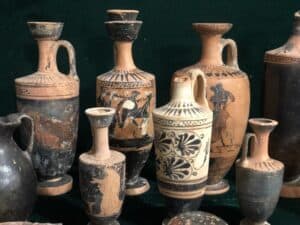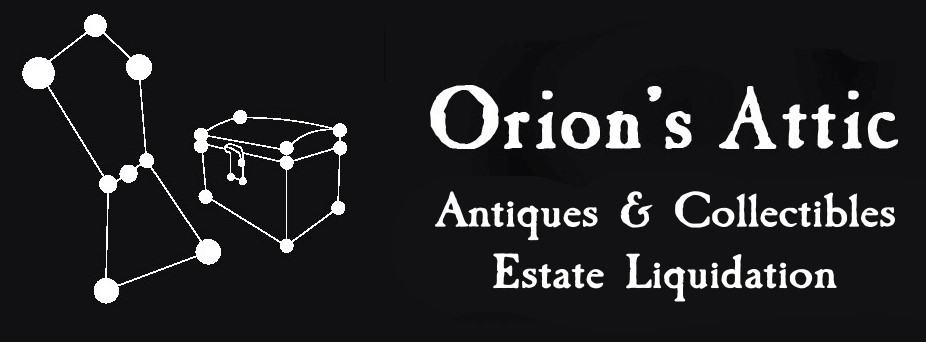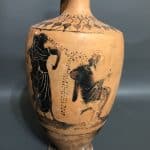 One moment I’m picking up a jaw-dropping collection of antiquities from a client ready to let go of her prized family heirlooms that have been passed down for 120 years. The next, my passions are on fire as I’m traveling through the middle-Italian land of Etruria — a Mediterranean trading power in what is now known as Tuscany that flourished from the 8th to the 3rd century BC.
One moment I’m picking up a jaw-dropping collection of antiquities from a client ready to let go of her prized family heirlooms that have been passed down for 120 years. The next, my passions are on fire as I’m traveling through the middle-Italian land of Etruria — a Mediterranean trading power in what is now known as Tuscany that flourished from the 8th to the 3rd century BC.
Abandoning all other life interests, I dig deeply into Italy’s first great culture — not only Etruria’s gift for making pottery that would last for 2,500 years and counting but its government, religion and history, including its tragic end at the hands of the Romans. I even find myself sailing on an ill-fated merchant ship intending to deliver a bounty of Etruscan pottery to a foreign port before it sinks to the bottom of the sea. Our clients’ treasures also send me on side trips further back in time to Sumer, nestled between the Tigris and Euphrates rivers in 2000 BC and to the Indus civilization of 2600 BC in what is now Pakistan and India.
Reading about ancient history is one thing; holding it my hands is quite another. It is in the true sense of the word awesome. I am overwhelmed with emotion, wonder and respect.
Two weeks fly by before I come up for air and list the mind-boggling finds in the new Ancient Pottery section of our Orion’s Attic eBay store.
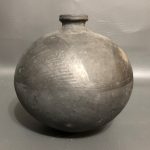
Etruscan bocchero pottery vessel
One of the first pieces I list is an Etruscan bocchero round pottery vessel circa 700 BC. The glossy black pottery is one of Etruria’s famous pottery forms. I learn that the piece was likely made for funerary purposes — hence its extraordinary condition. Etruria, I learn, was a well-to-do region. The Ancient History Encyclopedia entry on Etruscan civilization becomes my new favorite web site and one that launches me in 50 exciting new directions:
“Prosperity was based on fertile lands and improved agricultural tools to better exploit it; rich local mineral resources, especially iron; the manufacture of metal tools, pottery and goods in precious materials such as gold and silver and a trade network which connected the Etruscan cities to each other, to tribes in the north of Italy and across the Alps, and to other maritime trading nations such as the Phoenicians, Greeks, Carthaginians and the Near East in general.”
I learn that the Etruscans practiced divination — attempting to seek knowledge of the future through supernatural or occultic means — and that their religion was polytheistic “with gods for all important places, objects, ideas and events, which were thought to affect or control everyday life.” The Etruscans’ focus on religion extended to one of their greatest legacies — tomb wall paintings, something only the elite 2 percent of the population could afford.
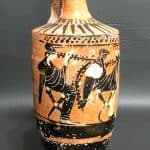
Ancient Greek lekythos
Etruscans made many other contributions to art, architecture (Tuscan columns, arched gates), government and more before the Roman army slaughtered and enslaved them. I want to remain in Etruria to learn more about the vanquished civilization but our clients’ collection of ancient objects has other destinations in mind for me. I list for sale in our eBay store a black terracotta jug from Campania, Italy — to the south of the Etruscans. Then I’m off to ancient Greece around 500 BC, where I get to investigate the first of several oil vessels known as a lekythos and imagine how they were used — primarily for anointing with perfumed oil the dead bodies of unmarried women. I study the black figure pottery images on the vessels and yearn to know exactly what the artists were depicting.
I bounce back and forth between Greece and the southern Italian regions of Magna Graecia and Gnathia, examining
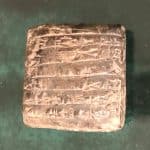
Sumerian cuneiform tablet
a pair of oinochoe — small wine jugs with white painted leaves. I am enchanted by more objects with tongue-twisting words like an ancient aryballos (perfume flask) with black painted ducks and a pair of skyphoi (black-glazed wine cups). I admire an ancient Greek oil lamp and squint my eyes to imagine what flickering images it would have illuminated.
The next stop in my time machine sets me down in 2350 BC in Sumer, an ancient civilization in the Mesopotamia region of what is today southern Iraq. I pick up a one-inch square Sumerian cuneiform tablet. The Sumerians developed cuneiform, one of the earliest systems of writing. Some scholars believe that it was the Sumerians who conceived of the idea of expressing thoughts in written language and that they later took it to the Egyptians. A note accompanying the tablet states that it was found in 2350 BC and was a receipt for goats brought to market. This note is the original document our client’s grandparents brought home when they obtained all the items on a grand world tour around the turn of the 20th century. As someone who has devoted much of my life to the written word, I am overwhelmed by the human history the tablet represents. Incredible.
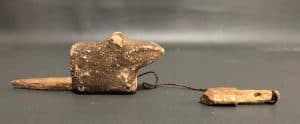
Indus civilization clay pull toy
My head spinning from jet lag, I still had yet one leg to complete on my journey. I pondered what l looked like some sort of a mouse pull toy carved out of stone. It was definitely old, but how old? And how could anyone carve a rock like that without modern tools? I struck out on my first few attempts to figure out what I had in front of me before finding a fellow researcher with the answers. It was old toy alright but much older than I expected. The piece is made of baked clay, not rock, and could date as far back as 2600 BC and the Indus Valley civilization. Along with Mesopotamia and Ancient Egypt, the Indus was one of three early civilizations of the Old World.
Many toys like this have been found there. This one, from my research, likely would have had wheels when it was made. The string is likely a replacement. Forget the flaws; I find it spectacular. I’m still trying to wrap my head around the idea that as far back as 4,500 years ago, a human being had it in his or her mind to make a toy for a child.
I always get enormously sentimental about antique toys; I had never held an ancient one. I picture a child’s joy upon receiving a hand-crafted gift from a loving parent and it makes me tear up every time. If only all of life could be as simple and sublime as the force that puts a smile on a child’s face. If only we could all love each other as much as we love our own families.
While it is our job to sell our client’s collection of Etruscan pottery and other family heirlooms, this project is the kind that makes me and the rest of the Orion’s Attic team want to get out of bed in the morning — the never-ending search to find treasures we’ve never seen before and to find new owners who will love them for another generation. It’s also the kind in which the thrill of success will be muted by my own sadness of having to say goodbye to these incredible pieces of ancient history.
Especially the mouse.
Do you have great stuff to sell? Orion’s Attic provides estate liquidation, estate buyout, consignment and appraisal services throughout the greater Maryland, Washington D.C. and Virginia region — and sometimes beyond. Contact us today to schedule a free consultation.
